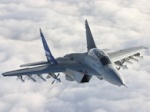Industria militar Sueca
+2
J0SEFERNAND0
Gerardo
6 participantes
Página 1 de 1.
 Re: Industria militar Sueca
Re: Industria militar Sueca
J0SEFERNAND0 escribió:¿Ya India compró los Grippen?
Esta en el concurso junto al MiG-35
 Re: Industria militar Sueca
Re: Industria militar Sueca
SUECIA Y NORUEGA A COOPERAN EN EL PROYECTO ARCHER DE ARTILLERIA
26-08-2009 - BAE Systems y Bofors cooperan en el proyecto Archer que es un sistema móvil de artillería ligera, transportable por aire y altamente automatizado con calibre155/52 que pueda golpear blancos con gran exactitud a una distancia de 50 kilómetros (30 millas). La automatización asegura de que el equipo pueda disparar el arma en el plazo de 30 segundos de llegar a la posición, y sin dejar la cabina. El Archer pertenece a la misma clase que el sistema Caesar de Nexter (Francia), G6 de Denel (Sudáfrica), y Atmos-2000 y Rascal de Soltam (Israel). El Archer ha sido un proyecto sueco, administrado por su agencia de adquisición de FMV. El financiamiento se ha proporcionado para el desarrollo del sistema y una cierta producción inicial, pero el futuro del proyecto es incierto por los bajos presupuestos suecos para la defensa. En mayo de 2007, un memorándum de entendimiento fue firmado con la agencia de adquisición de FLO de Noruega. Ahora, se esta desarrollado en conjunto el sistema de artillería Archer, y un contrato inicial está en estudio. El Archer ha sido diseñado para disparar la munición dirigida por GPS, Excalibur, así como las sub-municiones antitanques PRIMA de Bofors y Nexter.
Según los términos del acuerdo Sueco-Noruego de co-desarrollo, también utilizará un arma M151 de Kongsberg, en una torrecilla accionada por control remoto de vigilancia para autodefensa. El diseño y desarrollo del sistema está programado para continuar hasta 2009-2010, con un prototipo final que se entregará en septiembre de 2009 y un segundo prototipo antes de finalizar el año. En ese punto, los gobiernos suecos y noruegos tendrán una opción para comprar hasta 24sistemas Archer cada uno a un precio preestablecido. Los planes iniciales de entrega será el otoño del 2011, aunque parece haber sido postergados para más adelante.
http://www.espejoaeronautico.com/index.php?scp=news&id=7191
26-08-2009 - BAE Systems y Bofors cooperan en el proyecto Archer que es un sistema móvil de artillería ligera, transportable por aire y altamente automatizado con calibre155/52 que pueda golpear blancos con gran exactitud a una distancia de 50 kilómetros (30 millas). La automatización asegura de que el equipo pueda disparar el arma en el plazo de 30 segundos de llegar a la posición, y sin dejar la cabina. El Archer pertenece a la misma clase que el sistema Caesar de Nexter (Francia), G6 de Denel (Sudáfrica), y Atmos-2000 y Rascal de Soltam (Israel). El Archer ha sido un proyecto sueco, administrado por su agencia de adquisición de FMV. El financiamiento se ha proporcionado para el desarrollo del sistema y una cierta producción inicial, pero el futuro del proyecto es incierto por los bajos presupuestos suecos para la defensa. En mayo de 2007, un memorándum de entendimiento fue firmado con la agencia de adquisición de FLO de Noruega. Ahora, se esta desarrollado en conjunto el sistema de artillería Archer, y un contrato inicial está en estudio. El Archer ha sido diseñado para disparar la munición dirigida por GPS, Excalibur, así como las sub-municiones antitanques PRIMA de Bofors y Nexter.
Según los términos del acuerdo Sueco-Noruego de co-desarrollo, también utilizará un arma M151 de Kongsberg, en una torrecilla accionada por control remoto de vigilancia para autodefensa. El diseño y desarrollo del sistema está programado para continuar hasta 2009-2010, con un prototipo final que se entregará en septiembre de 2009 y un segundo prototipo antes de finalizar el año. En ese punto, los gobiernos suecos y noruegos tendrán una opción para comprar hasta 24sistemas Archer cada uno a un precio preestablecido. Los planes iniciales de entrega será el otoño del 2011, aunque parece haber sido postergados para más adelante.
http://www.espejoaeronautico.com/index.php?scp=news&id=7191
 Re: Industria militar Sueca
Re: Industria militar Sueca
Saludos:
Muy interesante ese sistema de artilleria, su alcance y movilidad lo hacen destacar.
Muy interesante ese sistema de artilleria, su alcance y movilidad lo hacen destacar.
 Re: Industria militar Sueca
Re: Industria militar Sueca
Saludos:
Lachas furtivas Visby, usan helicópteros A-109E
Fuente:
http://www.espejoaeronautico.com/index.php?scp=news&id=7215
Lachas furtivas Visby, usan helicópteros A-109E
PRIMER ATERRIZAJE DE UN HELICOPTERO A109 SUECO SOBRE UNA CORBETA
Categoria: Marina - 04-09-2009 07:21
La marina sueca ha realizado el primer aterrizaje de su helicóptero naval A-109E sobre una corbeta de la clase Visby. El primer A-109E, designación sueca HKP-15, aterrizó sobre el navío como parte de un programa de la administración sueca de calificación del material para la defensa (FMV). Los ensayos de calificación sobre la cubierta continuarán en septiembre y serán finalizados en octubre con más despegues y aterrizajes en el mar. Las fuerzas armadas suecas están poniendo énfasis en las operaciones de helicópteros a bordo de navíos como parte del plan de continuar su implicación en la operación de la unión europea "Atalanta" contra la piratería. Dicen que una nave con helicópteros puede supervisar un área mucho mayor haciendo uso de los sensores y la velocidad del helicóptero. También proporcionan una oportunidad mejor de identificar y evaluar rápidamente los buques sospechosos. Una condición es que el helicóptero podría utilizar las naves como plataforma temporal entre las misiones. Mats Agneús, el capitán de la Corbeta Visby dijo que el helicóptero es una parte natural e integral de todas las operaciones marinas. Puede ser utilizado como una plataforma de reconocimiento, transporte común, transporte médico y mucho más. Es un recurso que en la marina faltó durante años de modo que estas pruebas son particularmente importantes.
Fuente:
http://www.espejoaeronautico.com/index.php?scp=news&id=7215
 Re: Industria militar Sueca
Re: Industria militar Sueca
ese helicoptero esta vetable o no?

eneas- Soldado Raso
- Cantidad de envíos : 110
Fecha de inscripción : 01/08/2009
Edad : 35
Localización : Venezuela
 Re: Industria militar Sueca
Re: Industria militar Sueca
que mala suerte ese helicoptero se ve bueno.... 


eneas- Soldado Raso
- Cantidad de envíos : 110
Fecha de inscripción : 01/08/2009
Edad : 35
Localización : Venezuela
 Re: Industria militar Sueca
Re: Industria militar Sueca
Subject: Saab Offers Supercruising Stealth to South Korea
Softwar 7/8/2008 4:19:17 PM
Saab Offers Supercruising Stealth to South Korea
Aviation Week & Space Technology
07/07/2008 , page 32
South Korea's combat aircraft requirement draws out advanced proposals from Western fighter houses
A Saab proposal to co-develop a stealth fighter with South Korea is raising the prospect of an Asian-European aircraft emerging to compete with the Lockheed Martin F-35 Lightning.
The South Korean project to build an advanced combat aircraft alternatively offers to fund developments of the Eurofighter Typhoon or to help sustain Boeing's waning fighter business'but there is also a strong chance that the ambitious program will collapse into yet another F-35 order.
Saab is pitching a new design for a supercruising stealth fighter to South Korea, as well offering the possibility of joining the Gripen next-generation program (AW&ST June 30, p. 42).
Boeing is putting forward developments of the F-15, including reviving a 1990s concept without tail fins, and it has also offered a new fighter design.
EADS is pushing developments of the Typhoon beyond the Tranche 3 standard, and also flagging the opportunity of participating in its combat drone project. It may also have submitted a clean-sheet-of-paper fighter concept.
Lockheed Martin meanwhile is telling Seoul that the F-35 Lightning will meet its needs. That's not surprising, since it has no business interest in supporting South Korean ambitions to co-develop a stealth fighter, which would surely become an F-35 competitor.
The diverse range of offerings from the four manufacturers reflects uncertainty in South Korea itself over combat aircraft development. The air force wants an advanced fighter, but various factions in the government, industry and military are debating whether the country should fill that requirement by buying off the shelf or by taking part in development of a new aircraft or major derivative.
The country has two substantive fighter requirements, F-X Phase III for 60 aircraft and then F-XX for 120. It also has a parallel domestic stealth fighter development program, KFX. The F-XX requirement calls for fifth-generation aircraft, so the hope is that KFX will fill that need through a joint program between South Korean and foreign industry, with the latter carrying up to 30% of the development cost.
But KFX is up for review this month by the administration of new President Lee Myung-bak. It may be canceled or restricted to co-production or assembly of an existing aircraft, boosting Lockheed Martin's hopes of an order for the F-35. An intermediate possibility would be South Korean involvement in less advanced developments of current production aircraft.
The manufacturers presented their ideas at an air force seminar in Seoul on June 26.
Saab has circulated two series of designs for South Korea, for single and twin aircraft, recent iterations of which have been designated P305 and P306, respectively. Its presentation at the seminar showed only the twin-engine design, probably reflecting South Korean views on how large an aircraft is needed. The air force's Warfare Development Group has described the KFX as having a capability between that of the F-15 and F-16. By 'capability' it must mean weight and thrust class, since a new stealth aircraft would be much more capable than even updates of the 1970s designs.
Saab gave no specifications for its design but the external weapons shown on a drawing suggested an aircraft length of 17-18 meters (56-59 ft.). Span is much less than the length, possibly about 12 meters. If those rough estimates are correct, then the Saab stealth fighter would be at least as large as the Typhoon.
Saab shows single- and tandem-seat versions of the design. Inlet configuration is similar to the F-22's, and the tail fins are canted. The trailing edge of the main-plane is swept forward, again like the F-22's, but the leading edge looks significantly less swept. A gun is mounted abreast the left inlet duct.
The manufacturer promotes the aircraft as a balanced multirole design offering broadband stealth, supercruise, 'range and endurance,' integrated sensors, avionics and weapons, and situational awareness through the human-machine interface. It also claims attractive 'low life-cycle cost, growth potential [and] exportability,' while dismissing 'extreme stealth' as 'suitable for tailored platforms.'
Internal weapons stowage seems to be limited, since Saab says the bays are optimized for the air superiority role, although it still describes the aircraft as multirole in high-threat scenarios. External stores would be carried for low-threat scenarios. One of the three bays is behind the pit and between the inlets, and the other two are in the lower corners of the fuselage under the wing.
With domestic development, 'upgrades and changes to the aircraft can be implemented according to Republic of Korea Air Force priorities without interference by [the] seller's government, etc.,' Saab argues, in a clear jab at Lockheed Martin. Brig. Gen. Lee Hee-woo, head of the Warfare Development Group, is opposed to a South Korean order for the F-35, saying the inaccessibility of its software will deny 'operational sovereignty' to the user.
Within South Korea, the defense ministry's Agency for Defense Development is the most gung-ho about KFX. It would have little to do if KFX were canceled, so it is lobbying for the project to fill the F-XX requirement and has already produced stealthy concept designs.
Perhaps surprisingly, Korea Aerospace Industry is far less keen on an advanced development. Apparently mindful of its technological limitations, it would like the government instead to order the proposed F-50 combat version of the T-50, its Gripen-sized supersonic trainer.
The T-50 was developed under the guidance of Lockheed Martin, using the F-16 planform. Holding out the hope of a later development that might satisfy the urge to advance domestic technology, Korea Aerospace is also showing a concept of a delta-wing F-50XL, an analog of the F-16XL that Lockheed Martin offered to the U.S. Air Force in 1982. But the F-50XL concept differs from the F-16XL in having a wing with a straight leading edge, rather than a cranked arrow, and it has canted tail fins.
Some politicians are in favor of the F-35 for the F-XX requirement, and it is clearly well placed because of its combination of capability and cost.
The F-50 seems a long shot. Air force Chief of Staff Kim Eun-ki says the immediate priority is to continue buying fighters in the class of the F-15K until neighboring countries begin acquiring fifth-generation fighters.
Hence Boeing's opportunity in pushing the F-15K, of which South Korea has already ordered 61. Boeing updated the F-15E to create the F-15K for F-X Phase I, added features again for Phase II, and now says the Phase III model would have a next-generation active electronically scanned radar, electronic warfare suite, and advanced memory and weapon systems.
The KFX would follow that, and Boeing seems to have shown the finless F-15 as a possible candidate for the advanced program. The advantage of such an aircraft would be lower radar reflections, weight and drag. Brad Jones, Boeing's KFX program manager, tells Aviation Week & Space Technology that the Super Hornet could also be offered for KFX, and he adds that Boeing has also proposed a completely new design.
Jones suggests, however, that given the cost and development timescale implications of an all-new fighter, the defense ministry will most probably pursue the development of an existing aircraft to meet the KFX requirement.
The F-35 is the main competitor for F-X Phase III, as well as a strong candidate for F-XX. The immediate need to keep buying aircraft in the F-15K-class does not necessarily exclude the F-35, which is significantly larger than the Typhoon, for example.
The EADS offering is an improved Typhoon. In its presentation, EADS suggests new interface technologies, further development of sensor fusion and sensor upgrades, among others.
An EADS representative says: 'The EADS approach to KFX is based on an overarching partnership with the Republic of Korea [RoK] for the future combat air system capability development, including on the one hand RoK participation in the development of the Eurofighter future enhancements, and on the other the joint development of an unmanned combat air system, offering the perfect mix in terms of RoKAF future capability, program affordability and Korean industry workshare.'
A top South Korean government think tank responsible for economic policy analysis judged the KFX economically not worthwhile in December 2007 and stood fast when ordered by the defense ministry to reconsider its view (AW&ST Feb. 11, p. 19). The new government under President Lee, whose defense policy is vague, stresses economic efficiency first and foremost.
According to an industry source, one of the foreign companies offering to participate has assessed the program cost at 10 trillion won ($9.5 billion).
A committee chaired by Defense Minister Lee Sang-hee will conduct this month's review.
The Agency for Defense Development has revealed successful ground tests on radar-absorbing material on a McDonnell Douglas F-4 fighter. The timing of the May announcement could be interpreted as an attempt to gain publicity for the country's advanced aerospace efforts, helping to keep the KFX alive.
It isn't clear whether the South Korean material is structural or a coating, nor, if it is a coating, whether it is a paint or a metallic compound.
The agency says it has been studying the material since 1999 and received good results from trials in an indoor test facility. The next step will be flight tests, which will be conducted 'soon,' it says.
Taiwan, whose technological capability is similar to South Korea's, tested an imported anti-radar material on an AIDC AT-3 jet trainer in 2001-03. The supplier was 'an overseas Taiwanese man,' local media reported.
The Korean agency also says it has acquired technology for stealth shaping and analysis. In a November presentation, it showed pictures of a 1/10 scale model in an indoor radar range.
The model represented the agency's K100 concept for a fighter that would resemble a twin-engined F-35 with a multifaceted nose.
The KFX project dates back to the South Korean Joint Chiefs of Staff's decision in November 2002 to acquire up to 120 fighters, which is the requirement known as F-XX. In 2004-06 it became the basis of the agency's fighter design study, which spawned two concepts, the K100 and K200, the latter being a twin-engined canard-delta fighter.
Like Japan's full-scale radar cross-section model tested in France in 2005, the model probably closely reflects the agency's ideas of what sort of aircraft it currently has in mind (AW&ST Feb. 11, p. 36).
Que interesante... la saab pensando en trabajar en aviones stealth...
http://www.militaryphotos.net/forums/showthread.php?135621-Vectoria-Light-Stealth-Fighter-A-1997-LiTH-Design-study

Cevarez- Sargento Ayudante
- Cantidad de envíos : 8038
Fecha de inscripción : 09/01/2010
Localización : Venezuela
 Re: Industria militar Sueca
Re: Industria militar Sueca
Aca les dejo la promo del Gripen para los Colombianos ,
ahora el gripen y que será el Su-35 killer
ahora el gripen y que será el Su-35 killer

Condor1- Soldado Raso
- Cantidad de envíos : 93
Fecha de inscripción : 30/06/2013
Localización : Venezuela
 Temas similares
Temas similares» Industria Militar India
» Industria Militar de Francia
» Industria militar Alemana
» Industria Militar Argentina
» Industria Militar Española
» Industria Militar de Francia
» Industria militar Alemana
» Industria Militar Argentina
» Industria Militar Española
Página 1 de 1.
Permisos de este foro:
No puedes responder a temas en este foro.






